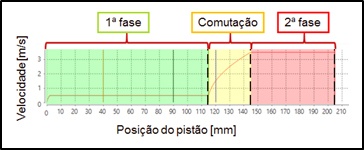Optimizing 1st phase velocity in high pressure die castings with the assistance of MAGMASOFT®
The injection curve is what defines how cavity filling happens on a high pressure die casting system (HPDC), being traditionally constituted by three stages, as seen in figure 1. The correct definition of this curve’s parameters is, therefore, of high importance for the quality of castings produced by this type of process.
In cold chamber high pressure die castings, the 1st phase velocity has great influence on trapped air within the shot sleeve, which in turn affects air porosity tendencies in the final part, as it can be observed in figure 2.
Since version 5.4 of MAGMASOFT®, it is possible to simulate filling including the shot sleeve, which in turn allows to validate the 1st phase velocities indicated in classic literature models.
The comparison between these models and casting numerical simulation was explained by MAGMA Engenharia do Brasil in the Webinar that took place on November the 6th of 2019.
*To access the link above it is necessary to be logged in the support area of the website.

